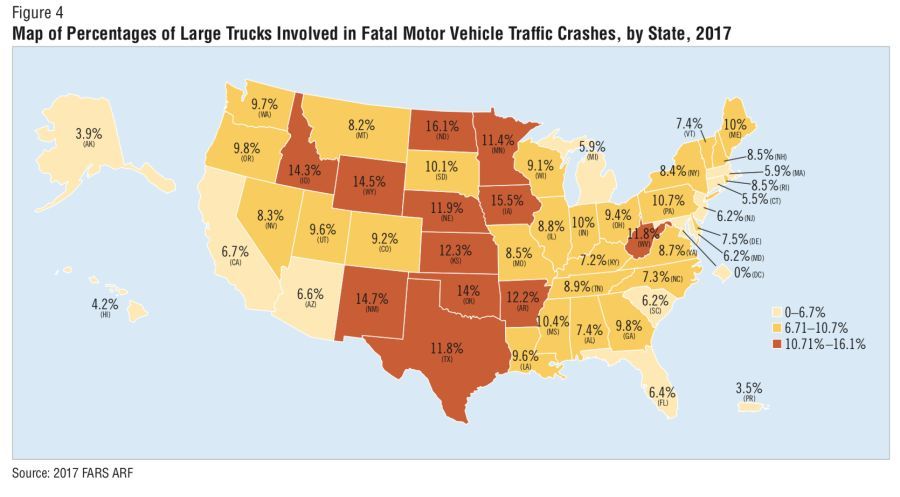Congress Introduces 65 MPH Speed Limiter For Trucks
Topic 25974 | Page 5

Congress Introduces 65 MPH Speed Limiter For Trucks
Just what we needed - bypassing DOT , congress seeks speed limiter bill...
Rick
Yeah, the 55MPH speed limit was such a hit too that did NOTHING to save lives.
DOT:
Department Of Transportation
A department of the federal executive branch responsible for the national highways and for railroad and airline safety. It also manages Amtrak, the national railroad system, and the Coast Guard.
State and Federal DOT Officers are responsible for commercial vehicle enforcement. "The truck police" you could call them.
Yeah, the 55MPH speed limit was such a hit too that did NOTHING to save lives.
Let me guess, the laws of physics don't apply to you either?
Here, for all of you geniuses, what do you have to say about this?
Trucking Fatalities Reach Highest Level in 29 Years
Deaths from large truck crashes reached their highest level in 29 years in 2017, according to National Highway Traffic Safety Administration data.
Fatalities from big truck crashes rose even though the overall traffic fatality rate declined, the agency reported.
Large truck fatalities rose 9 percent to 4,761, an increase of 392 lives lost over the prior year. About 1,300 of the deaths were truckers. The remaining 72 percent occurred in the other vehicle involved in the collision.
About 40 percent of truck occupants killed were not wearing seat belts.
Wow, I guess you guys must have missed that little tidbit in your in-depth research, eh?
Dm:
Dispatcher, Fleet Manager, Driver Manager
The primary person a driver communicates with at his/her company. A dispatcher can play many roles, depending on the company's structure. Dispatchers may assign freight, file requests for home time, relay messages between the driver and management, inform customer service of any delays, change appointment times, and report information to the load planners.
I did stop all that Brett. I went to one specific question which nobody wants to answer and has been posed by not only myself. Besides, since when is it up to opposition to prove the counter point? Several experts in a dozen states have already proven the danger of split speed limits but that's been ignored and the group pushing the legislation has provided no reports or statistics to back their claim.
Thank you for once again continuing to argue in circles without making a point. You just proved my point exactly.
Answer the question
Here's another little tidbit related to speed from this PDF about truck fatalities:
Now Texas is one of the few states with a 75 mph speed limit for trucks and it also has the highest average speed limit of any state in the country. Look at this from the PDF:
Texas had the highest number of large trucks involved in fatal crashes at 621, and the largest number of total vehicles involved in fatal crashes.
So the state with the highest average speed limit overall, and the highest speed limits for trucks, had the most truck fatalities.
Here's another:
The States with the largest percentages of large trucks involved in fatal crashes are in the West North Central, and West South Central portions of the country. Eastern and Western portions of the country have lower percentages.
So it's states with the highest speed limits that have the highest percentage of truck fatalities, and the states on the far East and far West coast which tend to have lower overall speed limits have a lower percentage of truck fatalities.
But please, don't take my word for it or anyone else's. I'm really hoping some of you will prove it to yourselves by doing the brick wall test. Don't worry, no harm will come to you. The laws of physics don't apply to you and your thick skulls will almost certainly keep you from any harm. They've obviously kept everything else out.

DOT:
Department Of Transportation
A department of the federal executive branch responsible for the national highways and for railroad and airline safety. It also manages Amtrak, the national railroad system, and the Coast Guard.
State and Federal DOT Officers are responsible for commercial vehicle enforcement. "The truck police" you could call them.

Yeah, the 55MPH speed limit was such a hit too that did NOTHING to save lives.
Let me guess, the laws of physics don't apply to you either?
Here, for all of you geniuses, what do you have to say about this?
Trucking Fatalities Reach Highest Level in 29 Years
Deaths from large truck crashes reached their highest level in 29 years in 2017, according to National Highway Traffic Safety Administration data.
Fatalities from big truck crashes rose even though the overall traffic fatality rate declined, the agency reported.
Large truck fatalities rose 9 percent to 4,761, an increase of 392 lives lost over the prior year. About 1,300 of the deaths were truckers. The remaining 72 percent occurred in the other vehicle involved in the collision.
About 40 percent of truck occupants killed were not wearing seat belts.
Wow, I guess you guys must have missed that little tidbit in your in-depth research, eh?
No. More truck crashes due to more trucks on the road. How hard is that to understand?
Safety impact of the 55mph limit: The (55mph) limit's effect on highway safety is unclear. Both during the time the law was enacted and after it was repealed, automobile fatalities decreased,[19] which was widely attributed mainly to automobile safety improvements, owing to an increase in the safety of cars themselves, and the passage of mandatory seat belt legislation by all states except New Hampshire from the mid-1980's to the early 1990's. [20][21] This decrease in fatalities from automobile accidents makes figuring out the actual impact of the law difficult. Although the vast majority of states reported fewer traffic deaths in 1974 compared with 1973, there were in fact three states where traffic deaths actually increased in 1974, 1975 and 1976, compared to 1973, notwithstanding the 55 mph (90 km/h) speed limit: Alaska, New Hampshire and Wyoming. [22]
According to the National Research Council, there was a decrease in fatalities of about 3,000 to 5,000 lives in 1974, and about 2,000 to 4,000 lives saved annually thereafter through 1983 because of slower and more uniform traffic speeds since the law took effect.[23] Later, the National Academies wrote that there is "a strong link between vehicle speed and crash severity [which] supports the need for setting maximum limits on high-speed roads" but that "the available data do not provide an adequate basis for precisely quantifying the effects that changes in speed limits have on driving speeds, safety, and travel time on different kinds of roads." The Academies report also noted that on rural interstates, the free-flowing traffic speed should be the major determinant of the speed limit: "Drivers typically can anticipate appropriate driving speeds." This is due, in part, to the strong access control in these areas but also is an acknowledgement of the difficulty of enforcing the 55 mph (90 km/h) speed limit in these areas.[24]
A Cato Institute report showed that the safety record worsened in the first few months of the new speed limits, suggesting that the fatality drop found by the NRC was a statistical anomaly that regressed to the mean by 1978.[25] After the oil crisis abated, the NMSL was retained mainly due to the possible safety aspect.[26]
Insurance Institute for Highway Safety analysts wrote three papers that argue that increase from 55 to 65 mph (89 to 105 km/h) on rural roads led to a 25% to 30% increase in deaths (1/3 from increased travel, 2/3 from increased speed)[27] while the full repeal in 1995 led to a further 15% increase in fatalities.[27] In contrast, researchers at University of California Transportation Science Center argue that the interstates in question are only part of the equation, one also must account for traffic moving off the relatively more dangerous country roads and onto the relatively safer interstates. Accounting for this they find that raising rural speed limits to 65 mph (105 km/h) caused a 3.4% to 5.1% decrease in fatalities.[28]
https://en.wikipedia.org/wiki/National_Maximum_Speed_Law
Interstate:
Commercial trade, business, movement of goods or money, or transportation from one state to another, regulated by the Federal Department Of Transportation (DOT).
Dm:
Dispatcher, Fleet Manager, Driver Manager
The primary person a driver communicates with at his/her company. A dispatcher can play many roles, depending on the company's structure. Dispatchers may assign freight, file requests for home time, relay messages between the driver and management, inform customer service of any delays, change appointment times, and report information to the load planners.OWI:
Operating While Intoxicated
Auggie69, you don't seem to realize that the quote you gave does not in fact back your claim that the 55 mph speed limit didn't save lives. It most certainly did.

Auggie69, you don't seem to realize that the quote you gave does not in fact back your claim that the 55 mph speed limit didn't save lives. It most certainly did.
Really?
Auggie69, you don't seem to realize that the quote you gave does not in fact back your claim that the 55 mph speed limit didn't save lives. It most certainly did.
Really? Then I guess your standards of reading comprehension are different than mine.
Really? Then I guess your standards of reading comprehension are different than mine.
Yes, they certainly are.
Here's a map showing the states with the highest percentage of fatal truck crashes. The states in red have the highest percentage of truck crashes that resulted in fatalities. Now all of you that travel the 48 states know that many of the states with the highest speed limits are also the states shown in red below. The states that tend to have lower speed limits have lower percentages of fatal crashes.

OWI:
Operating While Intoxicated
New Reply:
New! Check out our help videos for a better understanding of our forum features

















Preview:
This topic has the following tags:
DOT Driver Responsibilities Time Management Trucking Industry Concerns







 TT On Facebook
TT On Facebook
Robert, if you need studies to prove to you that slower is safer in an 80,000 pound rig then quite honestly you're delusional and God help the people on the highways around you. I've said all I have to say about it.